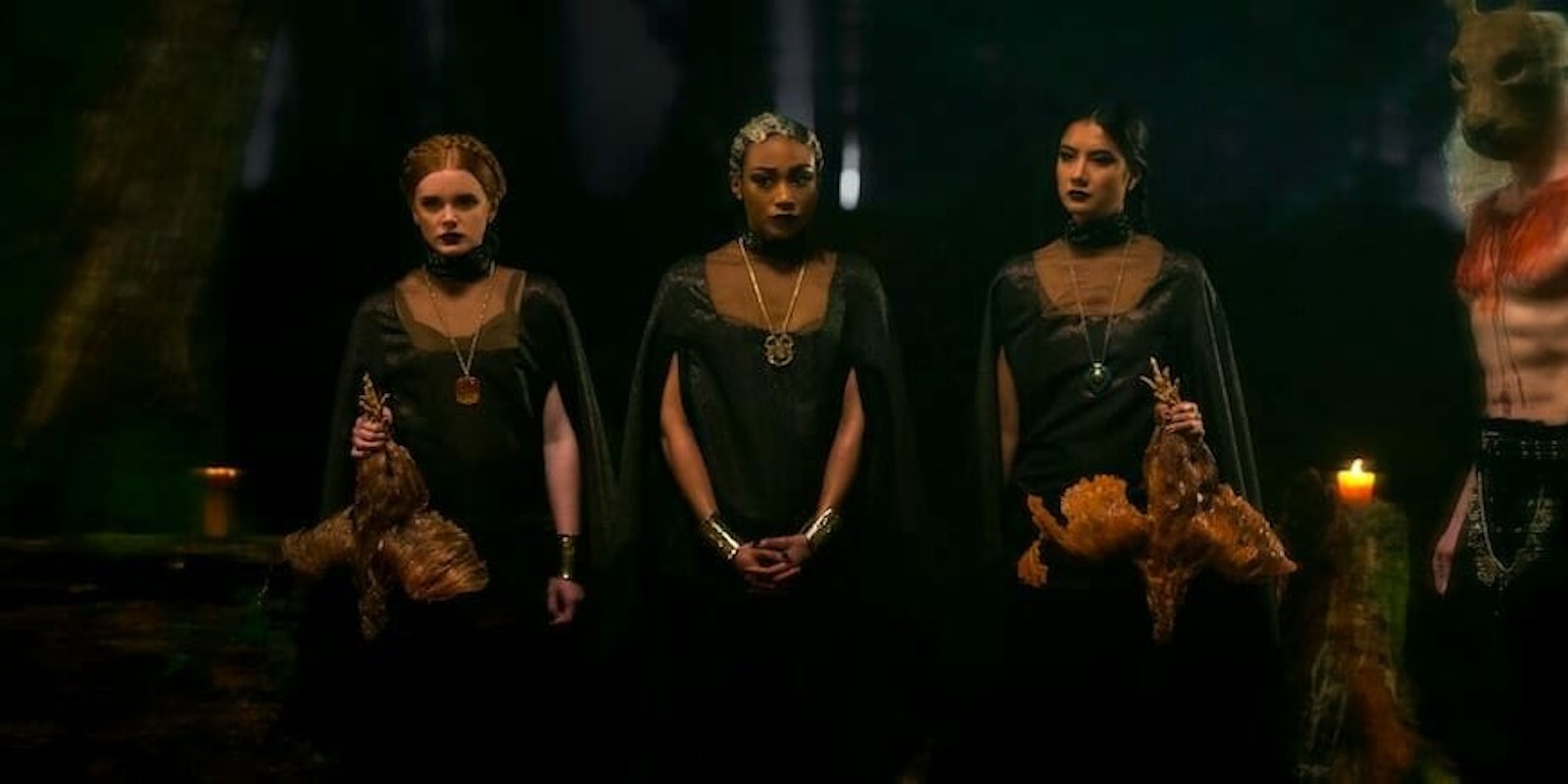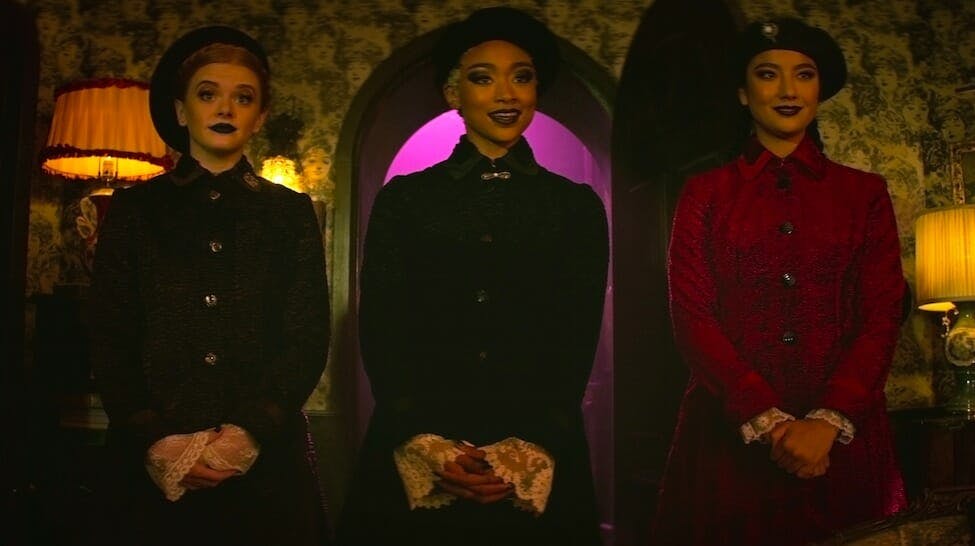I was five years old when The Craft came out in 1996. For years, the VHS tape taunted me at my local video store, but I wasn’t allowed to rent it until I was 13. Once I did though, you would have been hard-pressed to find me wearing anything other than black clothing (usually from Hot Topic) and a pentacle necklace (definitely from Hot Topic). My surface fascination with witches eventually turned into a legitimate one and I even made my mom give me a ride to Borders so I could spend my birthday money on Silver Ravenwolf’s Teen Witch, the adolescent’s guide to Wicca.
As a queer kid who was ostracized for my evident flamboyancy, my middle school years felt like a series of never-ending embarrassments (when I was 13, I did the poem monologue from 10 Things I Hate About You for a drama club audition and cried because I gave it my all). The Craft, and shows like Charmed and Buffy the Vampire Slayer, showed me that witches were strong and powerful forces of nature who didn’t allow themselves to be marginalized. They taught me to not let my insecurities or bullies hold power over me.
Two decades later, witches and the occult are no doubt having a moment in pop culture again. And this time, their empowerment of marginalized communities isn’t a subtext—it’s front and center, or at least it feels that way, comparatively.
This year alone, we’re welcoming American Horror Story: Apocalypse, Charmed (2.0), the upcoming Vampire Diaries spinoff Legacies, Midnight Texas, and Netflix’s The Chilling Adventures of Sabrina, all with queer characters and characters of color. The world has changed in a thousand ways in the 22 years since the premiere of Sabrina the Teenage Witch, and TV is finally ready to change right along with it.
In the cases of the new Sabrina and Charmed, these shows are building on what their predecessors did to empower women. But while the original Charmed is guilty of having a white feminist lens, the reboot features witches of color with varied socio-economic and cultural backgrounds. As Lauren Piester for E! puts it, in the original Charmed, “Boyfriends were established in the first few lines and romance often took over the series, even if those boyfriends often turned out evil and were then vanquished by the sisters.” While the OG series doesn’t hold up when it comes to the Bechdel Test or on the diversity front, Charmed part deux is far more woke, with all three starring roles going to women of color—the most vocal of the group being a militant lesbian feminist. Which is worth noting, as Piester points out, considering that the original show only had three confirmed LGBTQ characters throughout its entire eight-year run.
When it comes to Sabrina, the older series was a family-friendly sitcom that barely touched on feminism and opted for jokes of the lowest common denominator via a talking cat. However, the latest version, which debuted on Netflix on Friday, trades the one-note laughs for complex lived experiences that resonate with those who are often left out of cultural conversations on television.
“It’s been very refreshing to be in an environment that does reflect the real world and does reflect the human experience despite the fact that we are in a fictional, supernatural world,” Tati Gabrielle, who plays Prudence on The Chilling Adventures of Sabrina, tells the Daily Dot.
Her co-star Adeline Rudolph agrees that working on a diverse set is a blessing. “It’s very inspiring in many ways, and you can definitely feel the influences when you’re on set: I’ll be on the phone speaking Korean or German, and you’ll have Chance [Perdomo, who plays Sabrina’s warlock, pansexual cousin] speaking Spanish, and Tati is Korean too, so we will talk about our Korean heritage.”
Gabrielle and Rudolph make up two-thirds of the Weird Sisters, a trio of witches who attend the School of Unseen Arts and act as the title character’s main antagonists. “We hold a grudge against [Sabrina] because of her dual nature—both witch and mortal,” Rudolph explains. “In our eyes, witches were hunted like animals by mortals; we were hung during the Salem witch trials, and we just generally distrust them. There’s also an inherent divergence in beliefs between Sabrina and the Sisters.”
However, this feud doesn’t stop them from working together in the name of women and nonbinary folks supporting each other. Sabrina approaches the Weird Sisters for their help when her gender-nonconforming friend Susie is sexually assaulted by the football players at their school—a school whose principal hopes the bullying forces Susie to transfer. “I think it is a good lesson in sisterhood,” says Gabrielle, “and I hope that audiences, with all of these shows coming out, start to gather [around] that idea, because sisterhood is what we need.”
“It’s important to show that different people with different beliefs can come together to do what’s right,” Rudolph adds. She mentions that even “the warlocks support the witches and their agenda, and vice versa” on the show. “It’s a collaborative effort in fighting for equality.”
At the heart of The Chilling Adventures of Sabrina is the feminist battle against the patriarchy, one that’s intersectional. In fact, the central plot of the season focuses on consent and bodily autonomy. The belief system at the core of Sabrina’s coven hinders women from making choices that directly affect them—not unlike the plight of women IRL. The language used by the patriarchal leader drips with aggression toward strong women—entire monologues about how she must “submit fully to [his] will” and diatribes about men being the dominant sex run rampant—and these ideas are never played for laughs.
The premiere of the new Charmed is rooted in similar footing, with the show’s leads taking on men who see fit to oppress women. And it’s no secret why these series feel the need to tell these particular stories en masse.
For the past year, the Me Too movement has brought forth story after story of women being harassed, abused, and oppressed by men in power. More recently, women watched with empathy and discomfort as Christine Blasey Ford was forced to relive her trauma from an alleged assault by then-Supreme Court nominee Brett Kavanaugh; in the end, those in power dismissed her truth and rewarded Kavanaugh with the highest judicial seat in the nation. Stories about women not being believed are nothing new; they were around in the ‘90s when Melissa Joan Hart was too busy obsessing over date night outfits to comment on the sexist way the media covered the Monica Lewinsky scandal. But these stories are harder to ignore now. Especially if you are creating a show about young women and the powers they hold (spells) and do not hold (much else).
While witchcraft may seem trendy these days, much like it was when The Craft inspired me (for instance, earlier this month, more than 100,000 people chose to participate in a mass hexing of Kavanaugh), there is a deeper connection between the real practice of Wicca and its community-strengthening that extends beyond its obvious attraction to outsiders.
“There is a leaning in toward stewardship, empathy, and gratefulness in Wicca and other witchcraft based religions that I think is missing in our society right now,” Amber Benson, who played a queer woman on Buffy the Vampire Slayer and who has studied witchcraft for her novels, tells the Daily Dot. “And I wonder if the uptick is a yearning inside people—especially people who understand what it means to be othered, disenfranchised, and maltreated—to turn to these Earth-based practices in order to reclaim this.”
This is a sentiment echoed by Gabrielle. “What Wiccan and pagan people value that I think is so interesting is an immense respect for nature and for the natural world,” she says.
Like me, Gabrielle also had an interest in magic as a kid. “When we were younger, we looked up spells and tried them, to see if we could make things float, and really play with that. If I could find any stick that was like ‘pretty,’ I called it my wand, and would play around the house and try to make things happen.”
I don’t know a kid who didn’t make-believe that they could fix the world’s problems (or at least their own) with a little hocus-pocus every now and then. So, when did we grow out of that? When did we stop believing we could affect change, through just our own sheer willpower and action? When did we become so jaded?
Probably when the bullies started telling us we weren’t worthy, and then societal institutions, presidents even, backed up those assertions.
So I guess it’s rather fitting that these powers-that-be like to imbue the term “witch hunt” whenever they are questioned for their dubious and discriminatory actions—because they may just be correct. Just like the fictional witches of Sabrina and Charmed, we in the margins understand the power we have in numbers, in unity, and in the fear that our very existence strikes in our enemies. Witches are the embodiment of what we should aspire to be: Engaged citizens who identify issues, decide a course of action, and proclaim that it can’t just be business as usual any longer.



